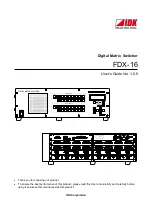
MES53xx, MES33xx, MES23xx Ethernet Switch Series
49
norepeat
number
consecutive characters in a new password.
no password complexity
no-repeat
Restore the default value.
passwords complexity
notcurrent
-/enabled
Prohibit the use of the old password when the password is
changed.
no passwords complexity
not-current
Allow the use of the old password when the password is
changed.
passwords complexity
notusername
-/enabled
Deny the use of the username as a password.
no passwords complexity
not-username
Allow the use of the username as a password.
Table 5.18. System management commands in the privileged EXEC mode
Command
Action
show passwords
configuration
Show information on password restriction.
5.6
File operations
5.6.1
Command parameters description
File operation commands use URL addresses to perform operations on files. For description of
keywords used in operations see Table 5.19.
Table 5.19. Keywords and their description
Keyword
Description
flash://
Source or destination address for non-volatile memory. Non-volatile memory is used by
default if the URL address is defined without the prefix (prefixes include: flash:, tftp:, scp:…).
running-config
Current configuration file.
mirror-config
Copy of the running configuration file
startup-config
Initial configuration file.
active-image
Active image file
inactive-image
Inactive image file
tftp://
Source or destination address for the TFTP server.
Syntax:
tftp://host/[directory/]filename.
-
host
- IPv4 address or device network name;
-
directory
- directory;
-
filename
- file name.
scp://
Source or destination address for the SSH server.
Syntax:
scp://[username[:password]@]host/[directory/]filename
-
username
- username;
-
password
- user password;
-
host
- IPv4 address or device network name;
-
directory
- directory;
-
filename
- file name.
logging
Command history file.
usb://
Source or destination address on an USB drive.
5.6.2
File operation commands
File operation commands are available to privileged users only.
Command line prompt in the Privileged EXEC mode is as follows:
















































